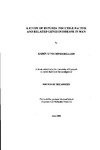A STUDY OF HYPOXIA INDUCIBLE FACTOR AND RELATED GENES IN DISEASE IN MAN
| dc.contributor.author | SØNDERGAARD, KAREN LYNN | |
| dc.contributor.other | Faculty of Health | en_US |
| dc.date.accessioned | 2013-10-31T11:42:51Z | |
| dc.date.available | 2013-10-31T11:42:51Z | |
| dc.date.issued | 2002 | |
| dc.identifier | NOT AVAILABLE | en_US |
| dc.identifier.uri | http://hdl.handle.net/10026.1/2496 | |
| dc.description.abstract |
In this study, the mRNA and protein levels of hypoxia inducible factor 1 (HIF-1α), and a number of genes regulated by hypoxia (VEGF, GLUT-1, p53), were determined in four breast carcinoma cell lines, peripheral blood mononuclear cells (PBMCs) of patients with breast cancer and Type 1 diabetes (TIDM), and in human breast and brain tumour tissue. Breast carcinoma cells and PMBCs from both patients and normal controls were exposed to hypoxia (≤1% 0 2) and/or high glucose. Both up-regulated and down-regulated HIF-1α, GLUT-1 and p53 mRNA expression was observed in the breast carcinoma cell lines exposed to hypoxia and/or high glucose, and in controls for osmolarity, confirming that hypoxic regulation of HIF-1α, p53 and possibly GLUT-1 occurs post-transcriptionally. Conversely, up-regulation of HIF- 1α and GLUT-1 mRNA was observed in patients with TIDM exposed to high glucose. The GLUT-1 mRNA up-regulation observed in patients without complications differed significantly from normal controls, where up to a 2 fold increase in expression was observed over that of patients with complications. This may indicate that the expression and function of glucose transporters differs in these patients, potentially leading to fewer complications. Investigation of breast and glial cell tumour tissue demonstrated that both HIF-1α and GLUT- 1 mRNA expression levels increase with disease progression, indicating that up-regulation of HIF-1α is partly at the transcriptional level (Søndergaard et al, 2002). Follow-up survival studies in all patients with glial cell tumours showed that HIF-1α protein expression is a significant prognostic factor in cumulative overall survival. An additional investigation of p53 or p73 polymorphisms in the development of carcinoma of the breast did not find that they were significant risk factors in the development of the disease in the British Caucasoid population. Further studies are required using larger sample populations investigating HIF-1α protein to determine the precise role of HIF-1 in the response to hypoxia and angiogenesis in disease in man. | en_US |
| dc.language.iso | en | en_US |
| dc.publisher | University of Plymouth | en_US |
| dc.title | A STUDY OF HYPOXIA INDUCIBLE FACTOR AND RELATED GENES IN DISEASE IN MAN | en_US |
| dc.type | Thesis | |
| plymouth.version | Full version | en_US |
| dc.identifier.doi | http://dx.doi.org/10.24382/4490 |
Files in this item
This item appears in the following Collection(s)
-
01 Research Theses Main Collection
Research Theses Main


